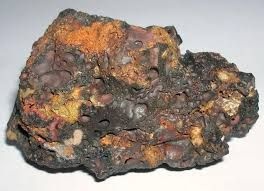
Slag is the glass-like co-product left over after a desired metal has been separated (i.e., smelted) from its raw ore. Slag is usually a mixture of metal oxides and silicon dioxide. However, slags can contain metal sulfides and elemental metals. While slags are generally used to remove waste in metal smelting, they can also serve other purposes, such as assisting in thetemperature control of the smelting, and minimizing any re-oxidation of the final liquid metal product before the molten metal is removed from the furnace and used to make solid metal.
In nature, iron, copper, lead, nickel and other metals are found in impure states called ores, often oxidized and mixed in withsilicates of other metals. During smelting, when the ore is exposed to high temperatures, these impurities are separated from the molten metal and can be removed. Slag is the collection of compounds that are removed. In many smelting processes, oxides are introduced to control the slag chemistry, assisting in the removal of impurities and protecting the furnace refractory lining from excessive wear. In this case, the slag is termed synthetic. A good example is steelmaking slag:quicklime and magnesite are introduced for refractory protection, neutralising the alumina and silica separated from the metal, and assist in the removal of sulfur and phosphorus from the steel.

Ferrous and non-ferrous smelting processes produce different slags. The smelting of copper and lead in non-ferrous smelting, for instance, is designed to remove the iron and silica that often occurs with those ores, and separates them as iron-silicate-based slags. Slag from steel mills in ferrous smelting, on the other hand, is designed to minimize iron loss and so mainly contains oxides of calcium, silicon, magnesium, and aluminium. Any sandy component or quartz component of the original ore automatically carries through the smelting process as silicon dioxide.
As the slag is channeled out of the furnace, water is poured over it. This rapid cooling, often from a temperature of around 2,600 °F (1,430 °C), is the start of the granulating process. This process causes several chemical reactions to take place within the slag, and gives the material its cementitious properties.
The water carries the slag in its slurry format to a large agitation tank, from where it is pumped along a piping system into a number of gravel based filter beds. The filter beds then retain the slag granules, while the water filters away and is returned to the system.
When the filtering process is complete, the remaining slag granules, which now give the appearance of coarse beach sand, can be scooped out of the filter bed and transferred to the grinding facility where they are ground into particles that are finer than Portland cement.



